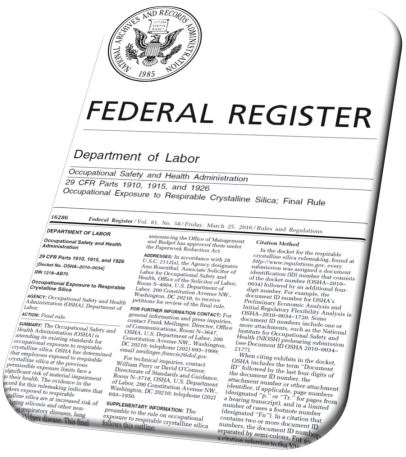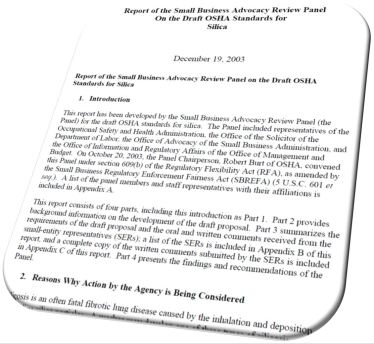
OSHA has issued its long-sought – and heavily disputed – new regulation aimed at reducing worker exposures to crystalline silica dust, cutting the Permissible Exposure Limit (PEL) in half for general industry, construction and maritime activities.
Office of Management and Budget (OMB) officials on March 21, 2016 cleared the rule, essentially green lighting OSHA to move forward. With this regulation long represented as a top priority for OSHA, Assistant Secretary of Labor David Michaels took no time doing so, issuing the final rule only days after  the White House gatekeeper OMB cleared it back to OSHA. Dr. Michaels said in the press release accompanying the rule that the existing limits on Silica dust are “outdated,” and added that limiting exposure to silica dust is essential.
the White House gatekeeper OMB cleared it back to OSHA. Dr. Michaels said in the press release accompanying the rule that the existing limits on Silica dust are “outdated,” and added that limiting exposure to silica dust is essential.
“Every year, many exposed workers not only lose their ability to work, but also to breathe. Today, we are taking action to bring worker protections into the 21st century in ways that are feasible and economical for employers to implement.”
The soon-to-be-published final rule – effective 90 days from its imminent publication in the Federal Register – cuts the exposure limit on respirable crystalline silica in half for general industry, construction and maritime, making the new PEL 50 micrograms per cubic meter (50 µg/m³) of air, on a time-weighted average of exposure across the work day. The PEL, which is the core provision of the rule, was controversial enough considering the little return Industry sees from the reduction, as compared to the economic and technical difficulties involved. However, the new regulation also includes an “action level,” set at 25 µg/m³, which automatically triggers numerous ancillary requirements ranging from exposure controls to medical surveillance. OSHA justifies this action level because many workplace health experts believe that even the new 50 µg/m³ PEL still does not suffice to protect workers from silicosis and other illnesses associated with chronic silica exposures.
making the new PEL 50 micrograms per cubic meter (50 µg/m³) of air, on a time-weighted average of exposure across the work day. The PEL, which is the core provision of the rule, was controversial enough considering the little return Industry sees from the reduction, as compared to the economic and technical difficulties involved. However, the new regulation also includes an “action level,” set at 25 µg/m³, which automatically triggers numerous ancillary requirements ranging from exposure controls to medical surveillance. OSHA justifies this action level because many workplace health experts believe that even the new 50 µg/m³ PEL still does not suffice to protect workers from silicosis and other illnesses associated with chronic silica exposures.
OSHA indicates that along with lowering the PEL, the revised comprehensive standard will also:
-
Require employers to (i) use engineering controls (such as water or ventilation) and work practices to limit worker exposure; (ii) provide respiratory protection when controls are not able to limit exposures to the permissible level; (iii) limit access to high exposure areas; (iv) train workers; and (v) provide medical exams to highly exposed workers.
-
Provide “greater certainty and ease of compliance” to construction employers by including a table of specified controls they can follow to be in compliance, without having to monitor exposures.
-
Stagger compliance dates to ensure employers have sufficient time to meet the requirements, (e.g., providing extra time for the hydraulic fracturing (fracking) industry to install new engineering controls and for all general industry employers to offer medical surveillance to employees exposed between the PEL and 50 µg/m³³ and the action level of 25 µg/m³³).
OSHA says employers covered by the construction standard have until June 23, 2017 to comply with most requirements, while employers covered by the general industry and maritime standard have until June 23, 2018 to comply with most requirements; additional time is provided to offer medical exams to some workers and for fracking employers to install dust controls to meet the new exposure limit.
Industry is poised to formally challenge the final rule, which business advocates have fought for years on both economic and scientific grounds, arguing that it will place extraordinary financial burden on industry with only speculative (or no) benefit. OSHA issued the rule Thursday, ahead of publication in the Federal Register, and parties will have 60 days to challenge the rule in the U.S. Court of Appeals.
Taken as a whole, these regulatory changes represent a significant new burden on industries, many with their own unique problems. In the construction sector, for example, many builders are concerned that the transient nature of their work environments and other factors will make the new restrictions infeasible from both economic and technical standpoints. There also appear to be very credible concerns that some of the requirements cannot be met with current technology, including measuring exposures at the 25 µg/m³ action level.
Industry groups earlier urged OSHA to go back to the drawing board because much of the science underpinning the rule is outdated. It is not a surprising position, because OSHA completed its small business review of the initial proposed rule way back in 2003. The Agency finished a peer review of the health effects and risk assessment for the rule back in 2010. And the current rule in one form or another has been pending for years.
The final rule will undoubtedly be challenged from many quarters. Groups opposing the rule will have 60 days after issuance to file petitions for review in US Courts of Appeal challenging the legality of the rule. OSHA’s issuance of the rule kicks off a period of “forum shopping” by the various groups that want to challenge it, as they seek the best venue to obtain a favorable ruling. That means there likely will be multiple petitions filed in different jurisdictions.
However, if history is any indication, once the anticipated challenges are filed, the Appeals Courts will undertake an effort to consolidate the lawsuits into one venue. In all likelihood the combined cases will be heard in the D.C. Circuit Court of Appeals because that court usually hears challenges to OSHA and other federal regulations.
Industry has a strong argument against the rulemaking from the perspective that it entails enormous costs compared to the speculative and little benefit that could actually result from OSHA’s effort to reduce exposure levels. However, a cost/benefit analysis is not the test that a legal challenge will turn on in a judicial decision as to whether to vacate the rule. Under the OSH Act, whether a rule makes sense from an economic standpoint is largely irrelevant. The tests for whether the rule is valid or not is whether it is economically and technologically feasible, and whether it is regulating a “significant risk,” all extraordinarily low standards to meet, giving industry an uphill battle in its challenge.
A last-ditch effort to stymie OSHA’s efforts could still come from Republicans in Congress, who over the years have put in either policy riders to slow or redo the rulemaking, or tried to actually zero out funding for it through the legislative text of appropriations. However, those efforts have done little to actually stop OSHA, and with President Obama still in office it would be hard to get such maneuvers through using spending bills, especially in an election year. Accordingly, Congress could try to pull a lever it’s only used only once before – and that was for an OSHA rule – the Congressional Review Act.
Republicans invoked the 90s-era law, which allows Congress under a fast-track process to veto an Agency rule after it is promulgated, to overturn OSHA’s ergonomics rule issued very late in the Clinton Administration. However, the silica regulations have been issued soon enough that any “resolution of disapproval” would have to pass Congress during President Obama’s term, allowing him to veto it, and it is not clear that critics of the rule have the numbers to override that veto.
We will be watching the Hill and the Courts with interest over then next few months to see what happens next. Stay tuned.